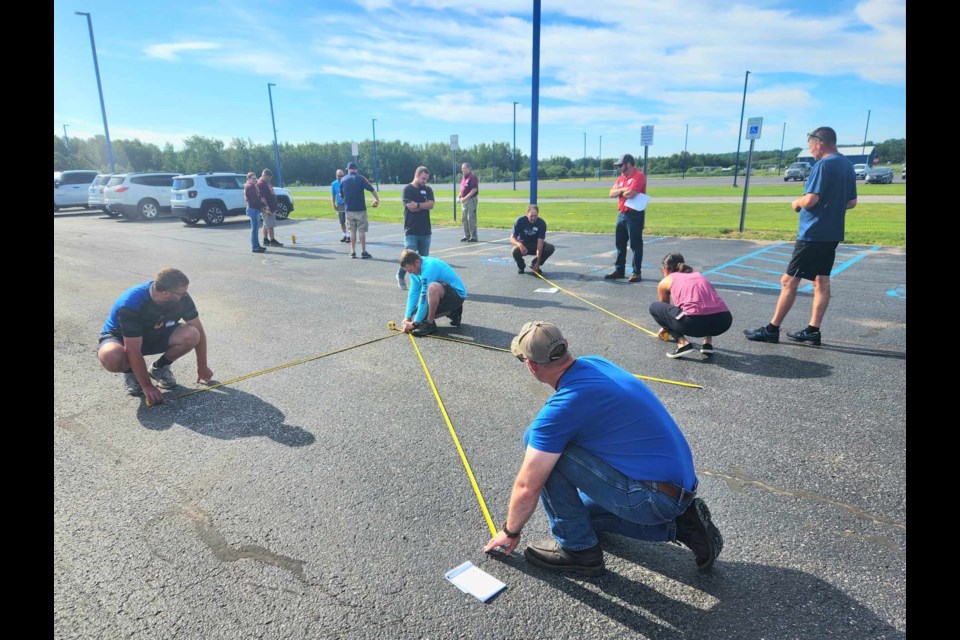More than 60 Michigan teachers jumped at the opportunity to reimagine mathematics by getting down and dirty in the MiSTEM Network 3-P Geometry in Construction and Algebra in Manufacturing workshops conducted at Sault Area High School and Career Center (SAHS) Monday through Thursday of last week to learn how to make math fun through creative application.
A group of teachers headed out to the school's parking lot on Wednesday morning, equipped with chalk and measuring tape to add some practical knowledge to their tool boxes. SAHS Teacher Rebecca Arbic helped facilitate the hands-on geometry instruction.
Arbic teaches Algebra 2 for the Trades, Geometry in Construction, and AMPED on Algebra/Algebra in Construction. She was the teacher responsible for inviting MiSTEM to the school and so much more.
"Becky Arbic has really been our regional Pioneer in working with Contextual Learning," Eastern Upper Peninsula (EUP) MiSTEM Region Director Kevin St. Onge said. "Contextual Learning is a company out of Colorado. Its teachers have developed the curricula for Geometry in Construction and Algebra in Manufacturing. Becky started working with them to facilitate sessions out-of-state, throughout various states."
Arbic thought teachers and students in the Great Lakes State should benefit as well.
"That is how we got started," St. Onge said. "MiSTEM was able to say, 'Hey, we can help fund this through the MiSTEM Advisory Council Grant for the Math Action Area."
According to Michigan Department of Labor and Economic Opportunity (LEO), the MiSTEM Network will award up to $200,000 in grants ($20,000 per grantee) to enhance STEM education in the state. In doing so, many Michigan teachers will learn how to implement 3-P learning.
"Teachers are here learning about three P's place: Place, Project, and Problem-based learning," SAHS Superintendent Any Scott-Kronemeyer said to introduce MiSTEM Network Math Action Area Lead, Southwest Region Director Diane Owen-Rogers, who explained further.
"The MiSTEM Network includes 16 regions across the state of Michigan," she said. "It's really a 3P: Project, Problem, Place-based alternative to having Algebra 1 and geometry. It's much more hands-on. The teachers here this week are from all over the state. They have been broken up into two sections. One course is focused on Geometry in Construction, and the other one is focused on Algebra in Manufacturing."
The MiSTEM Network has built on the basic foundations of STEM education, using transdisciplinary methods of engagement to grow a more effective math-based learning culture.
"Teachers are learning different ways to engage their students in Algebra 1 and geometry that is based in the real-world," Owen-Rogers said. "They are learning about the kind of business and industrial content they can bring into the math class in order to connect students with their future careers."
Scott-Kronemeyer has seen the impacts of this approach first-hand, crediting Arbic's Contextual Learning instruction for helping two of her own children "see math as a viable solution to real-world problems."
"My son needed to fix some parts on his car," Scott-Kronemeyer said to provide example. "He knew how to be resourceful, how to calculate, how to figure it out, and how to do the work needed. That came from Becky teaching him how to be resourceful, how to calculate, and how to figure it out."
While Contextual Learning concepts greatly benefit students interested in construction and manufacturing trades, its curricula was designed to help all learners apply math to everyday life. Each will certainly be faced with various problems at different point in their lives.
"Mathematics is just that," Scott-Kronemeyer said. "It is about solving problems. It is about solving puzzles by uncovering the concepts within them.'
"It gives math relevance," Arbic reiterated, during the hands-on geometry instruction in the parking lot.
Teachers got busy drawing corners for a mock 8-by-10-foot shed. Everything had to be perfectly aligned.
"Your foundation had better be square when you are constructing a building," Arbic said. "It also includes the properties of a rectangle that you would need in math class. That is the essence of what this program does. It marries the math to the geometry, and the geometry to the building. It is practical."
MiSTEM Network 3-P Geometry in Construction and Algebra in Manufacturing workshops aimed at helping teachers teach math to students in a more creative and applicable fashion could open doors of opportunity after high school graduation.
"Math gives our students a career path," Arbic said. "A lot of our kids want to stay up here. Math provides careers that allow for really good incomes. They can stay in the area they love with career opportunities. They can do anything in the trades from construction to welding to plumbing. There are a lot of unions up here, and really good paying jobs. I wanted to spread the love."
Click here to learn more: MiSTEM Network 3-P (Place, Project, and Problem-based Learning.



